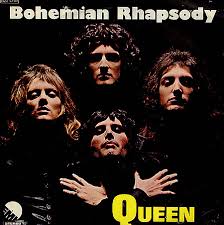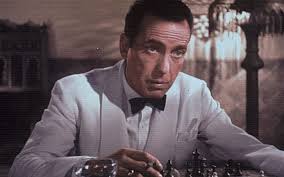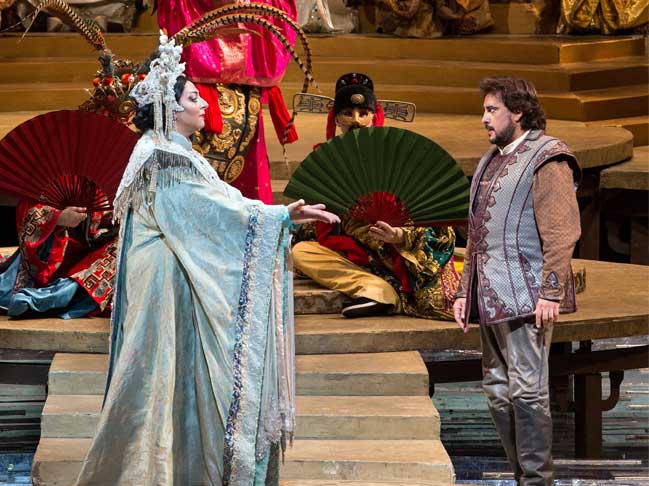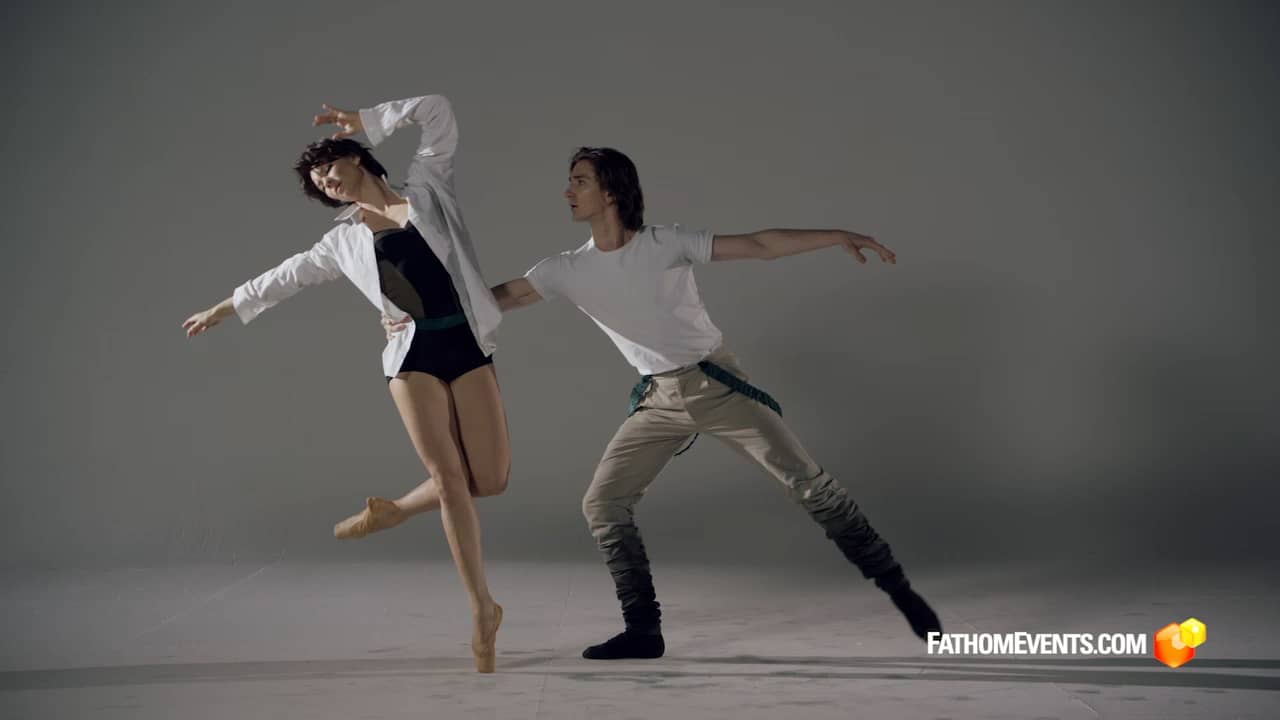
by Lidia Paulinska | Mar 22, 2016
On Sunday, March 13, 2016, Fathom Events presented a live cinematic performance of “Spartacus,” the Bolshoi Ballet’s signature piece, viewed by fortunate movie-goers for one showing only in 500 cinemas worldwide. This epic ballet premiered in Moscow in 1968, marking the 50th anniversary of the October Revolution, and 48 years later it continues to exhibit all the energy, fervor, and raw brawn which has characterized the very essence of the Bolshoi’s male dancers ever since.
Staged by the legendary choreographer Yuri Grigororvich with an oddly cinematic but functional score by Aram Khachaturian, “Spartacus” is nothing short of spectacular in its display of space-devouring leaps and astonishing Olympic athleticism by its two principal male dancers: The incomparable Mikhail Lobukhin in the title role of Spartacus, leader of an unsuccessful slave revolt against the evil Roman ruler Marcus Licinius Crassus, powerfully performed by Alexander Volchkov. Both Lobukhin and Volchkov are the very personifications of the unbridled male energy and muscularity the Bolshoi has come to be known for, and accordingly, in the case of “Spartacus,” subtlety of expression is definitely not it’s strong suite. With successive decades and interpretations of this iconic work, we’ve come to expect nothing short of broadly expressed, passionate male heroism and this current production doesn’t disappoint; in the world of ballet, the role of Spartacus stands as the coveted tour de force piece for every principal dancer to aspire to.
Ably complimenting the merciless Crassus is his cunning and crafty courtesan, Aegina, performed seductively by the beautiful Svetlana Zakharova whose flowing, erotic movements contrast with the harsh, angular, war-like virility of the male dancers.
The fourth principal in this remarkable production is Anna Nikulina who plays the pure and virtuous Phrygia, wife of Spartacus, a role in absolute contrast to the vampish, glittering, and irrepressible Aegina. However, the contrast is so great, I feel Nikulina’s demeanor, and even her drab costuming depict her as a bit too bland, even considering her character’s “slave” status. Yet all is redeemed by her exquisite partnering with Lobukhin in their wonderful pas de deux, a breathtaking show-stopper with each successive lift more incredible than the former, and possessing a lyrical, subtle beauty so uncharacteristic of this muscular piece in general. The contrast works beautifully.
On balance, “Spartacus” is an historic treasure that has fortunately not become an historic artifact even after almost a half century. A dynamism prevails throughout, from the very first scene with Crassus in command of a gold-clad army, wielding shields and spears, dynamically lunge-jumping and forward leg kicking reminiscent of Fascism, to the horrific “crucifixion” of Spartacus in the final act, lifelessly impaled on the bloody tips of dozens of spears, held high above the heads of his victorious slayers. “Spartacus” intrigued us and held our attention.

by Lidia Paulinska | Mar 2, 2016
Queen’s Bohemian Rhapsody was written 40 years ago by Freddie Mercury. It is a song that put the band on the top of music arena. It has spent 14 weeks at number one, giving it the fourth longest stay at the top of the chart. Bohemian Rhapsody is in a list of the all-time best sellers, with 2.36 million copies sold. It is a six-minute suite of the style called progressive rock that abandons the danceable beat that defines earlier styles and is more likely to experiment with compositional structure, instrumentation, harmony, rhythm, and lyrical content.
As Fathom Event continues to search a unique content this time is bringing the legendary rock band to select cinemas nationwide in Queen: A Night in Bohemia, specially restored and re-mixed for the big screen on Tuesday, March 8. Commemorating the recent 40th anniversary, this special event showcases the first-ever live recording of the record-breaking song and includes a never-before-seen documentary featuring archive footage and interviews with all four members of the band. The screening captured Christmas Eve 1975 at the Hammersmith Odeon in London concert accompanying with documentary that deep into Queen’s archives to tell the story of iconic band.
Tickets for the event on March 8 can be found at Fathom Events at www.fathomevents.com/event/queen-a-night-in-bohemia

by Lidia Paulinska | Feb 28, 2016
The Maltese Falcon is a 1941 film noir written and directed by John Huston which marked Huston’s directorial debut. His screenplay was based on the novel of the same name by Dashiell Hammet, the great American mystery writer known for his hard-boiled detective stories and the creation of one of cinema’s most enduring characters, Sam Spade, the detective in The Maltese Falcon played by Humphrey Bogart. Co-starring with Bogart was Peter Lorre and Sidney Greenstreet as Kasper Gutman, the “Fat Man,” who at 61 years old and 300+ pounds was making his film debut which won him a much-deserved Oscar nomination.
Interestingly, Bogart, Lorre and Greenstreet were to be reunited a year later in another Hal Wallis production: Casablanca. Ironically, Huston initially offered the role of Sam Spade to George Raft who turned it down because of the “inexperience” of the director.
And indeed as a director new to the craft, Huston made every effort to create an innovative, evocative and professional work on every level of production and he succeeded famously. For example, he planned every second of every shot to the most minute detail, shot-for-shot setups making sketches of every scene.* Much to Hal Wallis’ delight, the film came in on time and under budget and proved to be an instant success at the box office.
John Huston (1906 – 1987) of course went on to write the screenplays for the 37 films he directed, many of which are today considered classics. In addition to The Maltese Falcon he created The Treasure of the Sierra Madre (1948), Key Largo (1948), The African Queen (1951) and many others.
One of the outstanding innovations of The Maltese Falcon was the brilliant cinematography of Arthur Edeson who was influenced by German Expressionism brought to America by German cinematographers during the 1920’s, a production style which is apparent in Edeson’s use of below eye-eye-level shots (for example, the low angle shots of Sidney Greenstreet when discussing the Maltese Falcon) and strong angular compositions combined with low lighting to create menacing shadows, all in black, white, and shades of gray.
Another innovation and by-product of Expressionistic technique shared with Orson Wells’ Citizen Kane which also premiered in 1941, was the low camera shots showing for the first time the ceilings of rooms in which the action was taking place, a commonplace today, but revolutionary for its time. Alfred Hitchcock, who in turn influenced Francois Truffaut, was to employ many of these Expressionistic techniques in his seminal films.
Huston’s film is the third version of the novel, the first having been attempted in 1931 with the same title and the second, titled Satan Met a Lady, starring Bette Davis was offered as a light comedy. By common consensus, Houston’s “Falcon” justifiably stands out as the true classic and a lasting cinematic treasure.
by Lidia Paulinska and Hugh McMahon

by Lidia Paulinska | Feb 14, 2016
January, Fathom events – Franco Zeffirelli’s classic production of Giacomo Puccini’s Turandot was presented by the Metropolitan Opera on January 30, 2016 and seen throughout the world in cinemas in 70 countries on six continents, compliments of Fathom events: “The Met: Live in HD” series.
Puccini’s final opera was first presented at Teatro alla Scala in 1926, two years after he had died, leaving an unfinished score. Zeffirelli has succeeded brilliantly in spinning this rather improbable fairytale (but aren’t all fairytales improbable) into a beautifully super-stylized Chinese fable with a mies-en-scene complete with enormous pagodas and richly imposing court scenes complimented with characters magnificently and lushly costumed and all of this imposing spectacle more than adequately filling the challenging 60’ x 60’ yawn of the Met stage’s proscenium.
Regarding the musical component of this total theatre equation, Soprano Nina Stemme was well matched to the extraordinary vocal demands of the title role. Her Turandot was strong and compelling, almost Wagnerian in it’s scope. Ably succeeding in thawing this iconic ice queen was heroic tenor Marco Berti in the role of the indomitable Calaf, answering as he did the three riddles that guaranteed Turndot’s ultimate affection. And finally, Anita Hartig’s moving interpretation of the self-sacrificing Liu was informed by a delicate, lyrical pathos complimenting the hopelessness of her unrequited love for Calaf.
But ultimately it’s all about the music, isn’t it? For after all, the audience, 4,000 strong (it’s the largest opera house in the world) leave the auditorium humming that famous Act III show-stopper “Nessun dorma” and of course the very word auditorium does mean “hearing place.” But is it in fact just for listening? Perhaps not, for as we know the word theatre is from the Latin theatron meaning “seeing place.” So it’s actually all about both “hearing” and “seeing” … all about both Puccini and Zeffirelli! And what a wonderful “hearing” and “seeing” experience this Turandot was!
by Lidia Paulinska and Hugh McMahon

by Lidia Paulinska | Jan 31, 2016
January, Fathom Events – On January 24th, 2016, Fathom events presented the Bolshoi Ballet’s breathtaking, non-stop production of The Taming of the Shrew based on Shakespeare’s comedy, broadcast from Moscow to big screen cinemas throughout the United States.
The Bard’s tale deals with the beautiful Bianca who is much sought after by Lucento and many other suitors competing for her hand in marriage. However, she must wait until her older sister, the irascible and shrewish Kathrina is married first. Petrucio then comes on the scene, attracted by the reward offered by Katherina’s father to any man willing to marry his impossible daughter. Katherina, brilliantly interpreted by Ekaterina Krysanova, is eventually “tamed” by the determined Petrucio, masterfully performed by Vladislav Lantratov, who has taken up the challenge, thus winning the reward money and a new bride which in turn frees Bianca to marry a patient and grateful Luciento.
Choreographed by Frenchman Jean-Christophe Maillot especially for the celebrated and iconic Russian company, Maillot’s choreography is fast-paced yet subtle, simple yet filled with excitement and surprises, a smooth-flowing, circus-like style he characterizes as neither pure classical nor contemporary but uniquely “immediate” and existing in the moment.
The occasional frenetic movements of the dancers contrasted with moments of graceful, lyrical expression which might suddenly explode into breakneck athletic dancing bordering on the acrobatic, creates an excitement which is perfectly ignited by the powerfully poly-stylistic music of Soviet composer Dmitri Shostakovich, which not only serves to propel Kate’s frenzied, “shrewish” antics but also provides a driving force … a continuity and cohesiveness to the production.
Maillot’s Taming is imaginatively “book-ended” by the opening and closing scenes, the former functioning as a foreshadowing of the conflicts to come and the latter a peaceful expression of resolution and loving accord.
Before the curtain even opens to Act One, there enters a beautiful woman onto the stage in the role of a so-called “Housekeeper,” setting the “shrewish” tone of the act which is to follow by her overly-purposeful, condescending attitude. Dressed all in black and high-heels, she critically surveys the audience and the orchestra who are preparing to tune up. She then sits on the floor and slowly begins to remove her high-heels, methodically replacing them with pink ballet slippers, then slowly rising to once again peruse an intrigued audience, she begins to exit, suddenly pulling open the curtain to reveal a stark white stage with dancers poised to action! We are thus prepared to expect the unexpected.
By contrast, the final scene, again all in white, but this time conveying a tone of peace and tranquil camaraderie. Bianca now is married to Lucento and Kate to Petrucio and the entire cast delicately mime drinking tea, pinkies appropriately raised, to the tune of “Tea For Two”* from the 1925 Broadway musical No, No, Nanette, an absolutely perfect coda to an absolutely wonderful production. As with all of Shakespeare’s comedies, so to with the Bolshoi’s magic interpretation, love conquers all.
* N.B.: In 1927 Shostakovich wrote a new arrangement for “Tea For Two” after winning 100 rubles in a vodka-inspired bet he couldn’t re-orchestrate the song from memory in under one hour. He did it in 45 minutes! Bravo Maestro and bravo Bolshoi!
by Lidia Paulinska and Hugh McMahon
Page 5 of 7« First«...34567»




